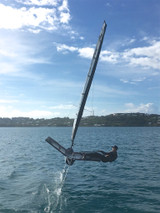Moth Worlds Developments - Lennon Sails

In the lead up to the Hayling worlds Lennon Sails were working closely with Chris Rashley and Kevin Ellway to develop the sails more quickly and combining the development into boat modification like the lower stump configuration. This work has continued and the refinements becoming ever. The body of knowledge and expertise was added to by Paul Goodison he came on board with Lennon last year.
The moth is basically overpowered sailing upwind once on the foils in solid way (you can sometimes be on the foils when there isn't really enough wind and for this you need the power) once your leaning on the sail you immediately need vang and downhaul. At this stage the top part of the sail is becoming redundant. It needs to “blade out” cleanly, disturbing the air as little as possible. This is now friction or parasitic drag - at best its acting as an endplate if it has a zero angle of attack - but on the whole upwind you would be better off without it.
To reduce drag we need to get the sail flat with straight exit to use as much of the available span as possible (for a constant lift a longer span reduces induced drag) - the membrane type sail with high modulus Technora and Twaron using our highly developed fibre layout, enables an exceptionally stable and user friendly sail, where we are forced to blade the top later up the range - meaning less drag. If a sail rounds up it section shapes or is over deep in one place compared to another causes drag in several ways.
This year to further lower the centre of effort the sail design we went longer on the foot and narrower higher up.
A lot of work went in the batten spec and entry angle - this led to a new cam set up being made available also. The new longer cams give more control on “rotation” and entry angle. This set up more tweaky in the dinghy park to rig but produces better performance down wind. Its not clear cut upwind but the cams are more likely to tack over compared to the standard short version which have a habit of locking on one tack.
In the end it can come down to a seat of the pants feeling to extract the best from any sail and in hours and hours of testing to see if one version is better than another with only tweak here or there between the iteration - this tiny detailed stuff can be missed in CFD modelling. Back when we used 3.8 impregnated Finn cloth, I recall one sailor who could tell time after time the difference between 4.9 and 5.1 (one hundredths of of an inch elongation at 10Lb) on the cloth test result in the finished sail. That’s a sensitive seat in your pants!
Click to view our Cams Video Tutorial
